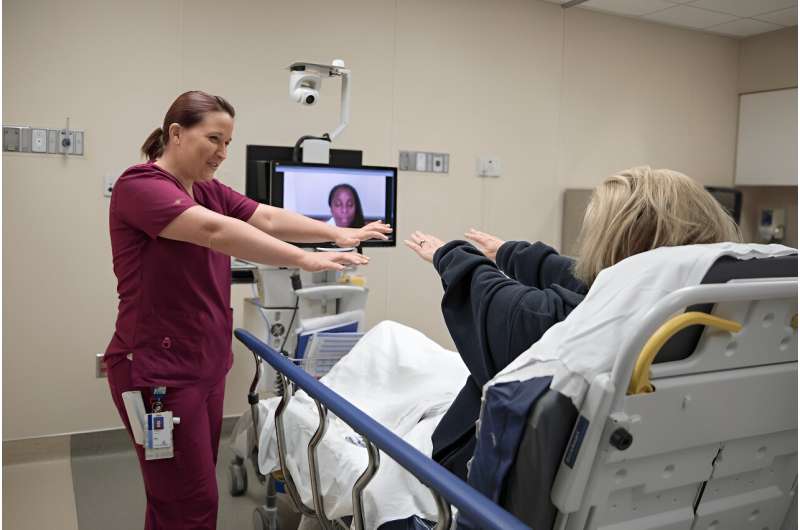This article has been reviewed according to Science X's editorial process and policies. Editors have highlighted the following attributes while ensuring the content's credibility:
fact-checked
trusted source
proofread
Stroke-care metrics improve with stroke center certification and coordinators

Key stroke-care metrics improve at telestroke hospitals with stroke center certification and stroke coordinators.
That's what NORC researchers at the University of Chicago found when they conducted an external evaluation of the telestroke program at the Medical University of South Carolina. NORC (National Opinion Research Center) and MUSC researchers report their findings in the Journal of Stroke & Cerebrovascular Diseases.
Mithuna Srinivasan, Ph.D., principal research scientist at NORC, is the lead author of the article and MUSC telestroke and telehealth experts Christine Holmstedt. D.O., Jillian Harvey, Ph.D., Ryan Kruis, Ph.D., and Shay McLeod are co-authors.
MUSC was chosen by the Centers for Disease Control and Prevention for evaluation by NORC to generate practice-based evidence and inform telehealth practice
Stroke is a leading cause of death and life-changing disability, and almost 800,000 people in the U.S. have strokes each year. Most of those strokes are ischemic or caused by a blood clot blocking an artery. Long-term disabilities due to ischemic stroke can often be minimized if patients receive appropriate treatment, but these must be administered within a very tight time frame of a few hours. Yet many people do not live near stroke centers where such therapies are available.
Telestroke was implemented to address this problem, using technology to allow specialists at hub hospitals to communicate with physicians and evaluate stroke patients at spoke hospitals across the state or region. A hub-and-spoke model organizes care through a central hub and secondary spokes: Hub facilities offer a full range of services, whereas spoke facilities offer fewer intensive services.
The impact of telestroke on stroke care and outcomes is widely acknowledged to be revolutionary. Undoubtedly, it has been a game-changer for improving stroke care in South Carolina, where MUSC launched its telestroke program in 2008.
"The telestroke program has had a huge impact on the ability of South Carolinians, especially those living in rural parts of the state, to access specialized stroke care," said McLeod, telehealth nurse manager for acute care services at MUSC.
Thanks to the telestroke program, all residents of the state now live within an hour of specialized stroke care.
Although the program had always conducted its own rigorous assessments and made improvements based on the data, its leaders were delighted by the opportunity for an independent evaluation by NORC and pleased that its findings showed the program's impact on patient care.
"The assessment confirms that stroke patient outcomes improve through the development of an evidence-based telestroke program," said Holmstedt, who is the program's physician leader. "Our hope is to inspire other institutions to develop similar programs to provide stroke care where it is needed most."
Telestroke's impact on the quality of stroke care is widely acknowledged, but it is less clear which aspects of telestroke are the most beneficial.
NORC and the MUSC researchers set out to examine whether two telehealth components, stroke center certification and stroke center coordinators, improve door-to-needle (DTN) time, or the time it takes after arrival at the hospital for eligible patients to be administered the clot-busting drug tPA, which can minimize disabilities post-stroke.
The study showed that spoke hospitals with both stroke certification and stroke coordinators had substantially better DTN times.
"Our unadjusted analysis showed that compared with spoke hospitals with neither of these two components, encounters at hospitals with both had nearly 20-minute faster DTN times," said Srinivasan.
Harvey believes that the findings of this external evaluation reaffirm the efforts of many of the spoke hospitals in MUSC's telestroke program.
"The findings highlight the additional benefits of employing stroke coordinators and taking the additional steps needed to become a stroke center," she said.
Srinivasan agrees and sees the importance of these findings for telestroke programs across the country, stating, "Having foundational infrastructure or stroke-care components, such as stroke coordinators and stroke center certifications, can certainly help to improve the quality of stroke care under a telestroke program."
In the study, smaller-sized and rural hospitals showed the strongest association between these two components of stroke infrastructure and improved DTN times.
"This might be due to a resource issue," said Harvey. "Larger hospitals already have a lot of resources and economies of scale, but bringing additional support to small- and medium-sized hospitals might be more meaningful and more impactful."
Finally, the study noted inequities in the distribution of telestroke resources. It documented fewer telestroke encounters for racial and ethnic minorities and found that many of them were treated in spoke hospitals without stroke center certification or stroke coordinators.
"As we scale up telestroke, we should take into account that rural and small hospitals may be less likely to acquire the components of stroke care tied to improved outcomes," said Srinivasan. "In rolling out telestroke, we must take care not to exacerbate disparities and lack of telestroke access."
Further studies are needed to explore the impact of other telestroke components, such as leadership and funding support, on stroke center metrics. Such studies would identify the elements of telestroke infrastructure most responsible for improved stroke-care metrics, providing a roadmap for efficient and equitable telestroke implementation.
More information: Mithuna Srinivasan et al, The role of stroke care infrastructure on the effectiveness of a hub-and-spoke telestroke model in South Carolina, Journal of Stroke and Cerebrovascular Diseases (2024). DOI: 10.1016/j.jstrokecerebrovasdis.2024.107702


















